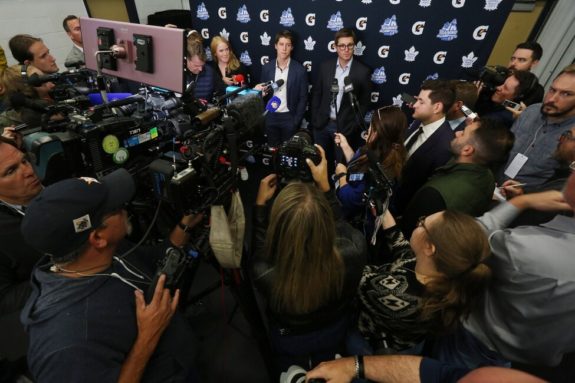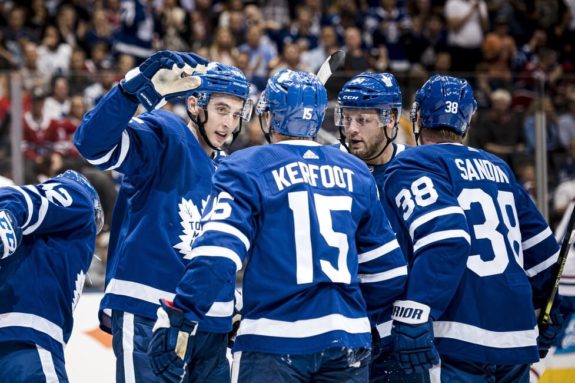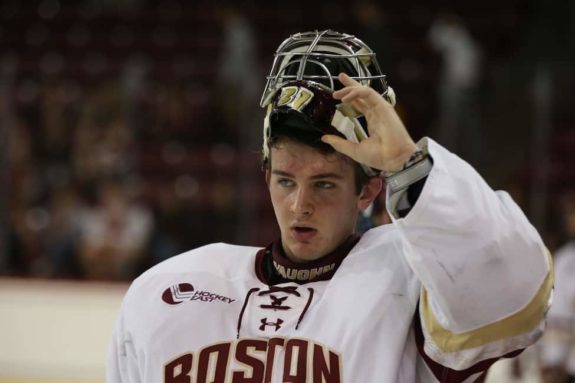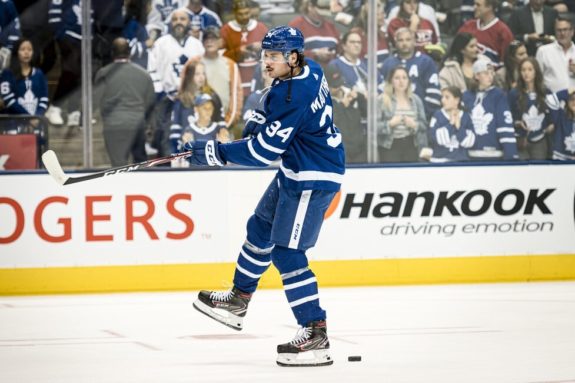Things look good for the Toronto Maple Leafs as the team begins the regular season. After the team’s first-round exit at the hands of the Boston Bruins – which was problem enough, the team went into the offseason with two huge issues.
The first issue was negotiating and signing prized restricted free agent Mitch Marner. After considerable drama, one day into training camp Marner agreed to a contract. The second issue was trying to MacGyver the roster to keep contracts under the upper limit of the salary cap. (MacGyver is used as a verb to mean the act of repairing something in

As all Maple Leafs fans know, damage control was needed because of the team’s self-inflicted salary-cap issues caused by having signed four players (John Tavares, William Nylander, Auston Matthews, and Marner) to contracts that totaled more than $40 million – almost half of the $81.5 million of that upper limit.
Related: Maple Leafs News & Rumors: Marner, Andersen, New Captain, Matthews
But, those problems were solved – and, to most fans’ minds, surprisingly well. Marner is home, and the Maple Leafs’ final roster moves set both the team’s roster and the roster of AHL affiliate Toronto Marlies.
Looking to the Maple Leafs Season
There’s excitement in the Land of Blue and White. I feel it, and from what I’m reading, fans share that feeling. The team looks powerful. New players have fit in well; and, even those with suspected flaws (Codi Ceci) have not shown their warts. Young prospects (Rasmus Sandin) have risen to the surface and have stayed there.
The forwards look great – no real surprise. The defense looks much improved. And, the team played well during

I’m probably too optimistic? With any professional sports team, things are far from perfect and the season is long. Part of putting this season’s team together necessitated decisions that impact the immediate future. As well, players are more than just forwards or defensemen; they are humans, and life seems to bring issues.
In this post, I want to discuss four potential problems I believe the Maple Leafs face with
Problem One: Was Dubas Wise to Stockpile Depth Players?
Obviously, teams with the best players have a better chance to win hockey games. The Maple Leafs are blessed with elite forwards, and because they wanted to keep them they paid them well. Dubas did not hesitate.
Related: Predicting the Maple Leafs’ Bottom Defense Pairing
However, having too many great players on high-priced contracts can haunt teams as the roster is built. Because each team must submit an “opening-day playing roster” of between 20 and 23 skaters prior to the start of the season, the Maple Leafs are required to carry a roster of at least 20 players (composed of 18 skaters and two goaltenders).
Given the Maple Leafs well-known salary-cap issues, general manager Dubas had no choice but to fill up his team with bargain-contract, depth players. Another choice would have been to rely on call-ups from the Marlies. Which would be the better way?
Dubas’ choice impacts both the Maple Leafs and the Marlies rosters. Spaces
Problem Two: How Should Young Goalies Be Developed?
There’s no question in anyone’s mind that Frederik Andersen is the team’s starting goalie. However, because his contract is over in two years, the team must prioritize the development of its goalie prospects. There are two strong-looking goalie prospects in the minors (21-year old Joseph Woll and 20-year old Ian Scott).

How far can these young goalies progress during the next two seasons, and where should they be playing? For example, should Woll be given the starter’s job with the Marlies, with 26-year-old Finnish goalie Kasimir Kaskisuo backing him up? Should Scott be given the starting job with the Newfoundland Growlers? Or, should both Woll and Scott be with the Marlies?
For now, Michael Hutchinson looks to continue his backup role to Andersen. He has NHL experience and has had some success. But, what if Woll impresses? Should he be promoted to the Maple Leafs as the backup next season, with Scott headed to the Marlies?
Related: Ranked: The NHL’s Top 100 Prospects in 2019
All this might seem a bit too forward-looking, but after two seasons – this season and next – the team must decide about Andersen’s future. And in two seasons, given the salary-cap situation, forget Andersen’s skills. Y
Problem Three: Can Matthews Rehabilitate His Reputation?
Matthews’ reputation has suffered over the past two weeks. No one denies his irresponsibility on two counts – being “disorderly” and hiding this issue from the team. Obviously, he hoped his deeds would slip by unnoticed. They didn’t.
The best Matthews’ supporters note that, “He’s only a kid. Kids do dumb things.” But others are not so generous. One Maple Leafs fan responded to a hockey article on Matthews’ goal-scoring ability by noting that, if Matthews scored more than 100 goals this season, it wouldn’t make his personal issues seem positive.
The jury is out (literally and figuratively) on Matthews’ culpability. How this is settled legally isn’t yet known; however, the Matthews-to-captain inauguration has all but disappeared. Most Maple Leafs fans agree that, with everything that’s happened, he might not be the best leadership model for the team.

How that impacts Matthews’ on-ice work is unknown. He seems to have recovered his on-ice game. Will his off-ice troubles continue; and, if they do, will they impact his play? Will this issue linger in the background all season?
Problem Four: Will There Be Fallout From the Choice of Captaincy?
There are two current concerns with the captaincy. The most obvious is who it will be. The second is how naming a captain was handled. Right now, hockey insiders and commentators suggest that Tavares has the inside track as the new Maple Leafs captain.
In a recent post, I had reported my suspicion that such was the case. Assuming Tavares will be named captain, as it looks right now, he seems like a good choice, but this is only his second season with the team. Does that matter?
As well, looking to the future, Tavares is getting to an age where his skills might begin to decline just as Matthews’ skills begin to peak. Is it impossible to completely forget the optics of naming Matthews captain? Without those two mistakes (being disorderly and hiding it) would he be in the running?
It’s easy to make a case that Matthews was
The bottom line is that the Maple Leafs next captain doesn’t have to be the best player or lead the team in goals or assists. The next captain needs to be someone with gravitas, integrity, team-centeredness, and a community orientation. Leadership in family-oriented teams must be built upon that foundation.
Related: Maple Leafs’ Kerfoot: What Should Fans Know?
What Maple Leafs player is up to the challenge of leading the team through the regular season and into the playoffs? That’s a question the team must consider. We will soon see the Maple Leafs choice.
These four problems seem ones the team will face over the next season and, perhaps, into the near future. I’m anxious (both excited and worried) to see how the team will navigate these waters.